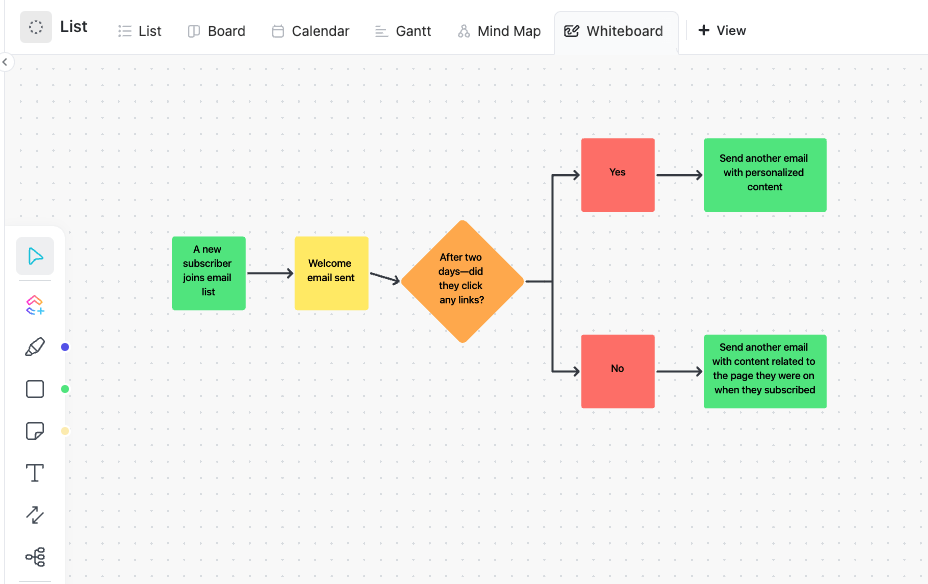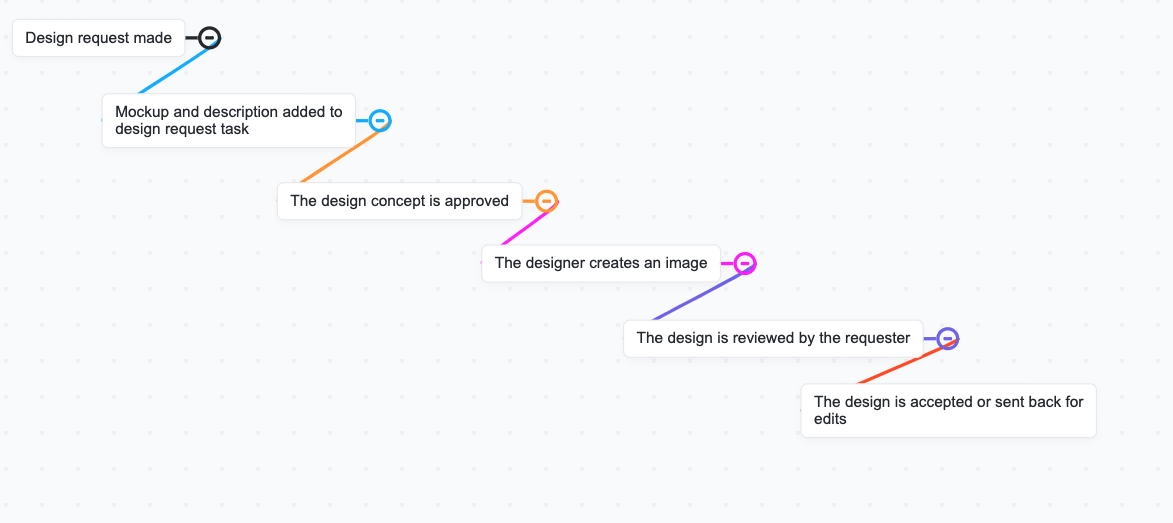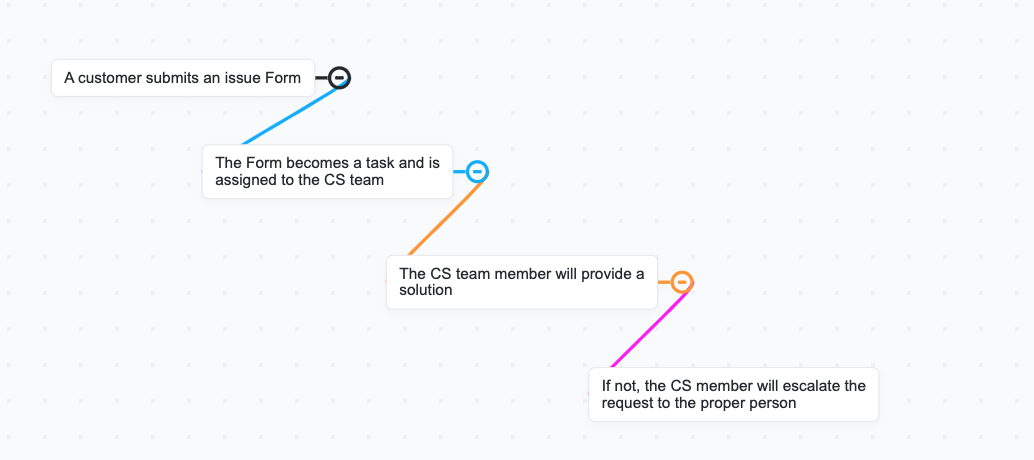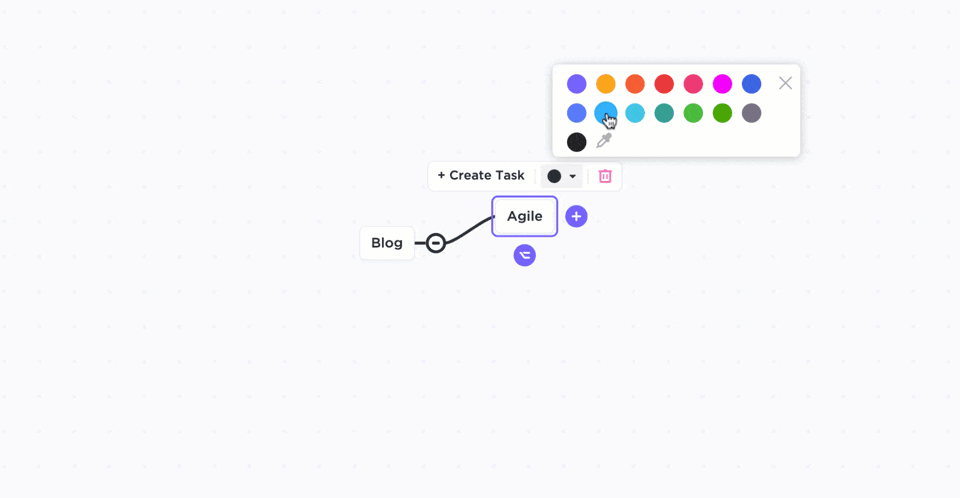16 Workflow Examples and Use Cases in 2025

Sorry, there were no results found for “”
Sorry, there were no results found for “”
Sorry, there were no results found for “”

On average, an employee wastes 26% of their workday on administrative tasks or due to outdated business processes.
Inefficient business operations and unclear responsibilities can quickly drain productivity and morale. That’s where workflows come in.
Whether you’re managing a project, onboarding a new hire, or running a marketing campaign, a well-planned workflow organizes, clarifies, and streamlines your team’s efforts.
In this guide, we’ll explore everything you need to know about workflows: what they are, how to create them, and real-life workflow examples from different departments. We’ll also show you how to overcome common challenges while implementing workflows.
By the end, you’ll have the tools and strategies to create workflows that keep your team running like a well-oiled machine. 😍
Here we go! 🙂🚗
A workflow is a series of repeatable process steps designed to achieve a specific outcome. Think of it as the backbone of any process—it’s how tasks, information, or resources move from one step to the next. Workflows bring structure to chaos by ensuring that everyone knows what to do, when to do it, and who is responsible.
For example, imagine an employee onboarding process. From sending an offer letter to setting up their workstation and scheduling their first training session, each step is part of a workflow.
Any workflow has five distinct parts:
There are four main kinds of workflows:
Every department in an organization makes use of specific workflows for their own processes. Some common examples of workflow use cases are as follows:
Let’s start with the basics here—what is workflow management?
Workflow management is the process of mapping out the order of actions you must follow to achieve a goal or complete a larger task. In this business process, you can also identify the actions that can be automated with the help of a workflow management tool.
This will smooth over or prevent lags between steps in your process to keep your workflow as productive as possible. So proactive! 👏
These workflow diagrams and examples will give you an idea of how different teams think through their processes, the platforms used to optimize these business processes, and how to create a workflow of your own. 💯
If you’re learning how to map workflows, ClickUp’s Simple Mind Map Template makes it easy to visualize each step and see how everything connects—all in one clear, flexible space.
When you find the perfect candidate, you want them on the team as fast as possible.
A streamlined recruitment process is essential for making this transition smooth and organized. It also shows the candidate that your company seriously has their sh*t together and that your interest in them is genuine.
Plus, a seamless workflow is the secret to ensuring that the right prospects find your opportunities and no candidate falls through the cracks.
By automating the busywork behind the recruitment process, your talent team can focus on what matters most—a candidate’s skills, values, and likelihood to succeed in the role. Here’s an example of what that looks like at ClickUp. 👉
💡Pro Tip: ClickUp’s Recruitment Action Plan Template can simplify and streamline your recruitment process. It includes a step-by-step guide that helps teams outline the recruitment process from start to finish, including job posting, resume screening, interview scheduling, and job offer procedures.
Attracting top-tier talent to your company requires careful thought and effort, but landing the perfect candidate is only half the battle.
The onboarding process is a new hire’s first experience as an employee and will set the tone for how they expect a company may treat them going forward.
More than a day of solitude to read the handbook or sign a stack of papers, the employee onboarding process is a critical first impression. Think of it as an opportunity to flex your company’s passion and ability to:
And so much more!
Onboarding should be as informative, engaging, and efficient as possible, which requires a well-planned workflow analysis to start every new employee off on the right foot. Before the offer goes out, here’s what the pre-onboarding process could look like in ClickUp:
RECEIVEDNEW HIRE status, which triggers a new task creation for ClickUp’s Onboarding team to take overBelieve it or not, the employee onboarding process begins before an offer is extended—it begins at first contact. Workflow apps are crucial for keeping track of communication, updates, and next steps throughout the entire onboarding process.
At ClickUp, changes to a custom task status trigger a new set of task automations to remove manual work from the onboarding team’s plate.
HIRED status, a comment populates for the Onboarding Trainer and hiring manager to connectOFFER SIGNED status, the new hire receives an automated ‘Welcome’ email with information to prepare for their first dayREVIEWREVIEW status, the Onboarding Trainer will know that all pre-boarding action items are completeDIRECTORY status, the new hire’s task will stay in the Directory List for the remainder of their ClickUp employment
Loving what you see here? Check out our blog for more details on how ClickUp’s Onboarding team uses ClickUp. 💜
💡Pro Tip: ClickUp’s Employee Onboarding Template is a pre-built template that can be used to streamline the onboarding process for new employees. This template provides a step-by-step guide covering all aspects of the onboarding process, including HR paperwork, company policies and procedures, training schedules, and more.
The customer onboarding process is just as important as your employee processes.
A choppy customer onboarding workflow may be the thing that stands in the way of your customers fully diving into your product, especially if it requires additional learning tools to fully integrate it among their team.
Here’s how Belén Papa, Digital Marketing Analyst at Flokzu, uses workflow automation to optimize her customer onboarding workflow:
You can automate reminders, emails, and reports depending on your workflow. When you register a new customer, you can enter all of their information in your system: country, language, company, etc. With Flokzu, we also turn that information into valuable metrics and statistics.
The workflow starts when you register the new customer. You can set an automatic personalized email where you welcome and invite them to their first meeting with a Customer Success Manager. During that first meeting, you establish joint goals and plans to show the customer how to get the most out of the service.
From this moment on, the CSM becomes a partner in the customers’ success and assigns the client to an Executive to continue the process.
With Flokzu, the Executive can set automatic reminders with due dates to follow up and ensure that every goal is achieved. Once the onboarding process ends and the client is stable, you can automatically notify the CEO and COO.

💡Pro Tip: Use ClickUp’s Customer Onboarding Template to create an efficient and consistent onboarding experience for customers. The template allows businesses to customize the customer onboarding process according to their specific needs and requirements, ensuring that customers receive the appropriate information and support they need.
Frfr, email campaigns are tough. 🥵
But a well-executed email campaign can bring in a lot of new attention and revenue to your business. Plus, it’s also a great and more personalized way of engaging with subscribers or customers that you want to pull further down the funnel.
So if you haven’t already gotten on the email workflow train, it’s time to climb aboard. 🚂
Beyond the customer relationship side of email marketing, your email campaign workflow should help you save time, manage customers across multiple channels, and be tailored to each campaign goal.
Let’s say a new user just subscribed to your blog. A welcome email campaign workflow will help you connect with that new subscriber, take your relationship a little further, and lead them to content on your blog that they’re likely to love.
Here’s an example of what that workflow might look like:

📮ClickUp Insight: When a goal falls short, only 34% of our survey respondents revise their strategy and 33% just give up. 🫢
But failure isn’t the end; it’s feedback.
You can easily unpack what went wrong with ClickUp Mind Maps and Whiteboards, explore new ideas, and chart a smarter course forward. Think of it as your built-in bounce-back plan.
💫 Real Results: ClickUp users say they can take on ~10% more work—because setting realistic goals means more wins and fewer meltdowns
Creating engaging content requires multiple stakeholders and clear communication.
This workflow ensures that every piece of content goes through ideation, creation, editing, and publishing without bottlenecks. It helps teams deliver high-quality content on time.
Example in ClickUp:
A workflow that I hold near and dear to my own heart. 💓
Producing high-quality content is crucial for establishing your brand as a leader in your industry. It draws in new potential customers, further establishes trust with your existing customers, and provides another opportunity to promote your product and services.
No surprise here, but at ClickUp, we use ClickUp to pull off a clear and functional content marketing workflow to publish as much content as we can on a regular basis. But there’s more than just one way for different teams to achieve their unique content goals.
Here’s how Kashyap Trivedi, Growth Marketer at Salesmate, created and implemented his content marketing workflow:
We use Salesmate’s Pipeline Management (Kanban) to manage our content flow for our marketing team. Basically, we broke down the entire content journey into a series of steps and turned it into a pipeline.
Once the deal (content card) is moved to the next stage, relevant people are assigned their next task using Salesmate Workflow Automation.

Want to know more about how different content marketing workflows and see how we customize our blog processes at ClickUp?
Look no further than this seminar from our LevelUp productivity conference! Learn the best practices and tools ClickUp has to offer for managing different parts of the web design workflow like, writers, designers, and developers.
💡Pro Tip: Marketing teams can use ClickUp’s Content Calendar Template to create and manage their content marketing strategy. This template helps teams plan and organize content creation, publication, and promotion, ensuring that they stay on top of their content marketing goals.
Making sure every design, copy, marketing, and product choice rings true to your brand is a full-time, all-encompassing job.
Like any HR request or lunchroom snack suggestion, all designs must adhere to a fixed approval process before they can get the green light. 🚦
That design process may look something like this:

Managing procurement involves coordinating with vendors, tracking purchase orders, and ensuring timely delivery.
This workflow keeps every step of the procurement process organized and efficient, reducing delays and errors.
Example in ClickUp:
Even if you work for a hip startup with unlimited PTO and vacation time—you’ll need to get the request approved by a manager.
An efficient vacation request workflow will help you stay on the good side of every manager (and HR) by keeping your vacay requests out of the team chat or busy email inboxes. Plus, an automated process helps your request go through faster! So you can start making your beach plans as quickly as possible.
Here’s another workflow shared by Belén Papa, showing how she implements her employee vacation request workflow:
In our vacation request process, you can see how much simpler the workflow can be when you automate the process with a BPM software like Flokzu.
Employees complete the personalized public form which is automatically sent to HR to accept or deny. You can set reminders and due dates to make sure HR decides quickly.
Once this decision is made, it will send an email notifying the employee if their request has been accepted or not. This option is extremely helpful for companies with hundreds of employees.

Sales orders include quotes, invoices, estimates, returns, product information, and more. That’s a lot to manage. 😳
No matter the size of your business or the industry, having a digital workflow to keep track of all sales orders is a must. This not only keeps you organized, cuts down on clutter, and helps you accurately track your profitability—it also does it faster.
Opting out of a digital sales order process can lead to significant delays while waiting on signatures or document approvals as you manually route tasks—and forgoing an automated workflow can be just as turbulent.
Digital forms and e-signatures completed in workflow management software can trigger new tasks or notifications when completed, helping teams process orders faster and from virtually anywhere.
Here’s an example of what a sales order workflow might look like:
Related: CRM Workflows

Adding new contacts to the database is crucial for building and maintaining strong customer relationships. This workflow ensures all relevant information is captured, organized, and ready for follow-ups.
Example in ClickUp:
Building new features requires coordination across multiple teams, including design, development, and QA.
This workflow ensures that features are developed, tested, and deployed smoothly while meeting deadlines.
Example in ClickUp:
There are a ton of moving parts behind every successful product launch—and maybe a few tears at some point too.
It is essential to align agile teams on all processes, messaging, and goals surrounding the product well before the launch, and it will take more than a detailed checklist to get the job done.
Here’s how Gabrielle Lafontaine, Head of Product Marketing and Partnerships at Unito, created and implemented her product launch workflow:
Product launches are hard, so we designed this template to facilitate the merging of planning (which happens in Miro) to ClickUp (where work actually gets dispatched and tracked).
Our launch involved months of hard work researching, planning, designing, building, and then finally launching, which means a LOT of cross-functional collaboration between product managers, developers, designers, marketing, and customer-facing teams.
Managing everyone in each department and ensuring they deliver on time without anything falling through the cracks can take a lot of effort. We used Unito to build this workflow, to help deliver the biggest and most complex product launches.


💡Pro Tip: Product teams can use ClickUp’s Product Launch Template to plan and execute a successful product launch. This template provides a step-by-step guide covering all aspects of the product launch process, including market research, product development, testing, and promotion.
Quickly resolving IT incidents is critical to keeping the business running smoothly.
This workflow ensures that issues like system outages or technical glitches are resolved efficiently and without affecting productivity.
Example in ClickUp:
Deploying new software or updates requires careful planning and execution to avoid downtime or disruptions.
This workflow ensures that all necessary steps are followed to test, approve, and deploy software efficiently while minimizing risks.
Example in ClickUp:
Customer success or support workflows are an excellent way to ensure that every customer’s questions are answered and needs are met in a timely manner.
Customers want to know that their voices are being heard and their experience with your product or service is important to you—and a dependable support process is key in achieving this.
This workflow is essentially the sequence of automated actions every customer support agent takes to resolve complaints, questions, or issues a customer may have. Issue resolution is one of the most common situations customer support agents will face on a daily basis, and part of what makes them so important is that these issues are often time-bound.
Meaning, you’ll want to tackle these issues ASAP.
In ClickUp, a support process workflow might look something like this:

Bonus: RACI Chart Examples!
Determine the workflow’s objective. Is it automating a repetitive process or improving task coordination? The objective will decide what sort of workflow you should create. Use ClickUp Goals to tie workflows directly to your team’s objectives
Break the process down into individual tasks and ensure no step is overlooked.
Visualize your steps with ClickUp’s Mind Maps for clarity. ClickUp Mind Maps are perfect for visualizing the step-by-step process of any project or workflow.
With its drag-and-drop functionality, you can map out and organize ideas. Then, you can drag branches to show task relationships and dependencies or adjust your nodes’ locations to organize and rearrange your workspace.

ClickUp Whiteboards provide an infinite canvas to draw workflows of any kind—even Mind Maps! Not to mention, ClickUp offers tons of workflow templates specifically for its collaborative Whiteboards to help you save time faster.
Add shapes that convert directly into ClickUp tasks and connect to your workflow, then draw connections between them to easily show the order of tasks.

Define who is responsible for each task since clear ownership ensures accountability. Use ClickUp Tasks to assign and prioritize tasks, add watchers, and more
Decide what should initiate each step of the workflow. Is it a completed task, a specific date, or an external input? Once you’ve worked that out, automate triggers with ClickUp Automations.
Run through the process to identify bottlenecks or missing steps. Find gaps or errors and fix them. Involve your team members and stakeholders in the process to ensure you’ve covered all requirements.
Write down the workflow for easy reference and share it with all concerned stakeholders. Based on feedback and experience, keep optimizing your workflows.
Centralize your workflow documentation in ClickUp Docs to keep all team members in sync.
Read More: How to Automate Repetitive Tasks
Teams might not fully understand the steps or goals of a workflow, leading to confusion and inefficiencies. This can occur when processes aren’t clearly defined or documented.
Solution: Clearly define processes. Map out every step of the workflow with input from team members who will be using it. Use flowcharts or tools like ClickUp Mind Maps to visualize the process.
Employees may resist adopting new workflows, especially if they’re accustomed to existing methods or perceive the changes as unnecessary or overly complex.
Solution: Explain the “why” behind the workflow to the team. Highlight how it will save time, reduce errors, and make their work easier.
Creating workflows with too many unnecessary steps can overwhelm team members, slow down productivity, and lead to errors.
Solution: Avoid overcomplicating workflows. Break processes into manageable steps and focus on achieving the desired outcome with minimal complexity.
Teams may lack the proper tools to support workflow implementation, such as project management software, automation tools, or integrations with existing systems.
Solution: Use reliable project management and workflow automation tools like ClickUp. Choose platforms that integrate with existing systems and are user-friendly.
Failing to communicate the purpose, benefits, and details of a workflow to the team can result in misalignment and poor adoption.
Solution: Encourage team members to share feedback about workflows. Regular check-ins can ensure that workflows are being followed and improved where needed.
If workflows don’t account for cross-team collaboration, they may create silos where important information or tasks are not shared effectively across departments.
Solution: Promote cross-team collaboration and design workflows that account for interdepartmental dependencies. Shared dashboards or centralized tools like ClickUp can eliminate silos.
Without regular monitoring, team members might deviate from the workflow, causing inconsistencies in results or delays in project timelines.
Solution: Use templates and automation to standardize workflows. Monitor progress through dashboards to ensure everyone stays on track.
Team members might struggle to follow workflows if they are not properly trained on how to use the tools or understand the processes involved.
Solution: Document workflows and offer hands-on training for the tools and processes involved. Consider creating easy-to-follow documentation or video tutorials for reference.
Regularly review and update workflows. As business needs change, workflows need to evolve. Teams that don’t revisit and update their existing workflows may find them outdated or ineffective over time.
Solution: Schedule periodic reviews to identify bottlenecks, redundancies, or outdated steps. Use insights from these reviews to optimize workflows.
When roles and responsibilities within a workflow are not clearly assigned, tasks can fall through the cracks, leading to delays and frustration.
Solution: Assign clear roles and responsibilities. Use tools like ClickUp’s task management to assign ownership for every task. Clearly defining responsibilities ensures accountability at every step.
Bonus workflow management resources:
There is a workflow example for literally everything. But you don’t want to jump between workflow software to carry out each process. Instead, use a single productivity platform that centralizes all of your workflows—no matter the size of your team or industry. AKA, ClickUp. 🤓
Among ClickUp’s library of fully customizable features are Mind Maps and a digital Whiteboard tool to create highly visual, engaging, and automated workflows for any use case. All without ever having to open another tab.
Digital whiteboard software is booming right now—but did you know that ClickUp is one of the few platforms to build our whiteboard feature in-house? 🏡
No matter business or industry, ClickUp will be your new favorite go-to for all things process and workflow-related.
And did we mention these features are completely free?
Start saving time by automating and streamlining your processes in ClickUp. ♻️
Sign up for free today.
© 2025 ClickUp